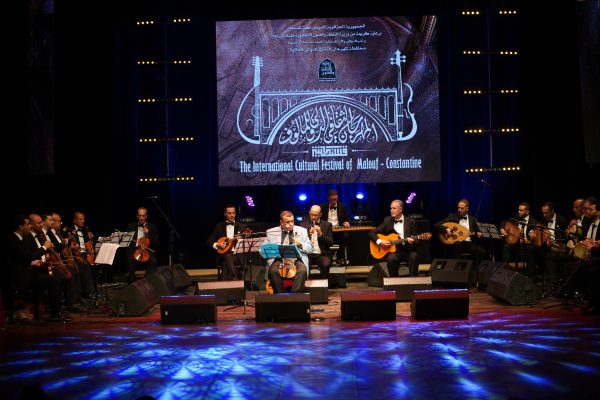Physical Address
Indirizzo: Via Mario Greco 60, Buttigliera Alta, 10090, Torino, Italy
Physical Address
Indirizzo: Via Mario Greco 60, Buttigliera Alta, 10090, Torino, Italy

The Mohamed Tahar Fergani regional theater plunged its spectators on Monday evening on a unique musical journey. Between the oriental sounds of Turkey, the first female interpretation of the Libyan Malouf, and the flawless mastery of the great Algerian classics, the third evening of the 13ᵉ International Festival of Malouf offered a mixture of tradition, virtuosity and emotion.
The evening began with an immersion in the eastern maqâmât, with the Turkish Arabesque duo Band, composed of the Tarkan and Simo Hakki brothers. All dressed in white, the two musicians offered a concert of rare virtuosity, where each note seemed to float in the air. Tarkan, master of the clarinet, and Simo, virtuoso of derbouka and song, explored a wide palette of Maqâmât, from Bayati to Nahawand, via the Hijaz and Mahur. “It’s something very natural,” says Tarkan Hakki. And to add: “We are two brothers from different musical backgrounds and playing together has established himself. Here in Constantine, we felt like at home. The public welcome was incredible, warm and passionate, a real happiness for us ”.

The duo also interpreted emblematic pieces of Arab and Turkish music, such as “Kadouka Al Mayass”, immortalized by the Syrian singer Sabah Fakhri, and the famous Mouwachah Andalou “Lama Bada Yatathanna”, creating a bridge between Andalusian heritage and oriental sounds. The obvious complicity between the two brothers, their sense of rhythm and their technical mastery captivated the audience, plunging the room into a musical universe where tradition and modernity respond.
The public was then transported to Libya thanks to the Al-Maqâm troupe, specializing in Malouf, Mouachahât and Arab music. Directed by Ahmed El-Hafi and accompanied by the young singer Intisar Attia, the troop appeared on stage dressed in traditional white outfits, symbol of purity and elegance. For this exceptional occasion, Intisar Attia marked history, becoming the first woman to interpret the Malouf in Libya since 1960. “I am proud to be the first Libyan woman to sing the Malouf”. And to explain: “It is not easy in a context that is still conservative, but it is an honor to represent the woman on stage and to show her talent. I discovered Malouf only a month ago, but I am passionate about this heritage and one day I hope to be able to interpret it in Libya, to share it with my people ”.
Give her place to the woman in the Malouf
For his part, Ahmed El-Hafi explains: “Our experience started in 2016, exclusively with male voices. Today, we are proud to present a female interpretation and give back its place to the woman in the Malouf. This moment is unprecedented and symbolic in the history of our musical heritage. We continue this adventure with the blessing of our masters and the desire to always move forward ”.
The troop bewitched the public with two emblematic noubas like “Qalbi Yahwa Aychek” (Maqâm Rasd Ed-Dhîl) and “Ahl El Hima” (Rasd Maya), mixing traditional arrangements and contemporary interpretation. Each note, each rhythm plunged spectators into the heart of the history and emotion of Libyan music, while nourished applause translated admiration for this unprecedented spectacle.
The musical journey continued with Fayçal Kahia, who came from Annaba, who chained with mastery of the most emblematic extracts of the Malouf, mixing Noubat, Msedrat and Betayhiyat. The artist interpreted “Ya Nas Ma Taâdirouni”, a prayer of forgiveness, followed by “Madha Nahit”, then the betayhiyat “Ya Saki Meskine Habibi” and “Bakiyat El Ghamami”. The emotion culminated with the sdjel “El Hawa Ya Sidi”, plunging the public into the intimacy of this secular musical tradition.

He underlines the importance of preserving this heritage. “Malouf appeared in the 16th century and crossed ten centuries without disappearing. It is essential to work at its registration with the intangible heritage of UNESCO, through methodical scientific work and rigorous learning. Of the existing 24 new, only 12 were preserved. What we transmit, ancient and current artists, is only a tiny part of this treasure ”.
For thirty minutes, the public was swept away in a whirlwind of sounds, discovering the Nouba Sika, extracts from the Nouba Dil, two Msedrat, two Betayhiyat, as well as the famous Ghazal El Affif, testimony of the wealth and the diversity of Malouf.
The evening was also an opportunity to pay tribute to Faouzi Abdennour, pupil of Master Mohamed-Tahar Fergani. He interpreted the Noubat Raml El-Kebir, attacking a repertoire deemed difficult. From the first agreements of his oud, the informed public understood the magnitude of the challenge, and Abdennour was able to combine fidelity to tradition and personal expression. “Malouf music is a cultural diplomacy for Algeria,” he explains. According to him, “we carry the soul of our country internationally and we must transmit this inheritance to the young generations. Traditional music, well carried and visible, can enhance our culture and our economy, while capturing young audiences, even in the era of commercial music ”.
Finally, a moving tribute was paid to the sheikh Brahim Améchi (1903-1990), a great figure of the Malouf Constantine. After a youth marked by sport and scouting, he turned to music in the 1920s, forming himself with Masters Bachtarzi and El Anka. Founder of the association “Mohibbi El Fen”, which became “Chabab El Fen”, he contributed to the training of the young generations and to the preservation of rare pieces like “Bachraf El Arissi”.
